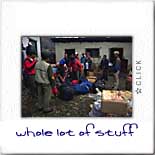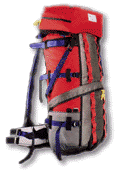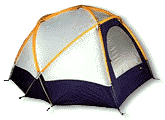
from Namche to Thyangboche
Map
of the Khumbu
The Gear
that got us there
April 1:
Kathmandu
April 2:
Kathmandu
April 3:
Kathmandu
April 4:
Lukla and Phakding
April 5:
Namche
April 6:
Between Namche and Thyangboche
April 7:
Thyangboche
April 8:
Thyangboche
April 9:
Dingboche
April 10:
Dingboche
April 12:
Lobuche
and
Beyond
Trek photos by Peter Potterfield, © 1997 The Zone Network. All rights Reserved.
![]()

 I traveled to Mount Everest in the spring of 1997 to report on climbing activity and coordinate The Mountain Zone's
live cybercast of Todd Burleson's Alpine Ascents International Everest
Expedition. Since I was in the role of trekker, not climber, I used this opportunity to review a wide range of mainstream climbing
and backpacking gear loaned to the Mountain Zone for the purpose of field testing.
The trekking gear I took was all four-season climbing and backpacking
gear — exactly the kind of stuff that is useful to most climbers, hikers
and backcountry users. (The high-altitude equipment used high on Everest
is so specialized that it's functional for only a handful of people for
a few days a year.) Our experience with the trekking gear
follows.
I traveled to Mount Everest in the spring of 1997 to report on climbing activity and coordinate The Mountain Zone's
live cybercast of Todd Burleson's Alpine Ascents International Everest
Expedition. Since I was in the role of trekker, not climber, I used this opportunity to review a wide range of mainstream climbing
and backpacking gear loaned to the Mountain Zone for the purpose of field testing.
The trekking gear I took was all four-season climbing and backpacking
gear — exactly the kind of stuff that is useful to most climbers, hikers
and backcountry users. (The high-altitude equipment used high on Everest
is so specialized that it's functional for only a handful of people for
a few days a year.) Our experience with the trekking gear
follows.
Dan McHale Packs: Critical Mass SARC

As seen on the backs of guides all over |
Pack maker Dan McHale's reputation has been hard won over more than a decade of building custom made packs for professional climbers and serious amateurs. Scott Fischer climbed exclusively with McHale packs, as do other high-altitude climbers. But increasingly his business comes from demanding weekend climbers and backpackers who want an extremely well-designed pack that fits comfortably and will stand up to hard use for years.
The details make the SARC so useful. Small exterior pockets are just big enough to hold a water bottle, or to keep wands, pickets, trekking poles and other hard-to-lash items from sliding off. Yet the slim profile is maintained, so the pack doesn't snag on rhododendron bushes or yak horns on Nepal's narrow trails. And while the pack is a simple "bag" design, a mid-point zipper permits access to the lower reaches of the pack without dragging everything out of it. A top compartment converts to a fanny pack when you're just roaming the hills around camp and need only a camera and a jacket.
But the heart of the pack is its unique suspension system; both shoulder rig (including hand-bent aluminum stays) and waist belt are custom fitted, which makes for a surprisingly comfortable burden. Fine adjustments can be made to subtly shift the load from hips to shoulder, increasing the level of comfort to such an extent that people who tried the pack out of curiosity were blown away.
REI Minus 20° Sleeping Bag

REI's Minus 20° bag: good value in a down sack |
The REI Minus 20° bag was a good compromise between weight and cold-weather capability: it was warm at the highest elevations, but weighed in at a reasonable four pounds. The two way zipper permitted plenty of ventilation lower down, and the dry loft outer fabric kept the 600-fill down protected from spills and dampness. We thought the black cover looked really cool. This is a good value in a high-performing down bag, a good choice for serious hikers and climbers.
REI Trekking Poles
At age 35, a lot of climbers and backpackers start hiking with ski poles to save their knees. I was no exception, and in the past decade or so I've become addicted to carrying a strong ski pole on long hikes or approaches. But as I prepared for the Everest trek, an unexpected dilemma emerged: all my gear had to fit into a big Sun Dog duffel bag, and the ski poles were way too long to fit in any duffel. The solution was an REI three-section telescoping trekking pole.
|
REI's telescoping trekking poles |
Telescoping trekking poles have become a de rigeur piece of equipment for globe trotting trekkers and climbers. The poles are an absolutely indispensable piece of equipment in Nepal, where everybody uses them. Some people get by with one (like me, I like to have one hand free) while others prefer poles in both hands. On the Everest trek, one essential use is protection from yaks. Often the route to Everest follows narrow trails above steep gorges, where meeting a string of five or six big-horned yaks is no joke. A yak horn or, or even a pack bag or barrel lashed to the animal's flank, can knock a dull or unsuspecting trekker right off the trail, right into the gorge, and kill him. It happens.
So if you ever find yourself on a steep trail in Asia with a string of pack animals approaching, here's the drill: Get on the uphill side of the trail and plant one's trekking pole directly at one's feet. The yaks seem to respect this demarcation, and plod placidly on without encroaching further on one's space. In the lodges, tales of outright combat with the big beasts is standard fodder over beers, so go armed with a good set of poles.
REI Geo Mountain Four

A spacious and beefy abode |
Sun Dog All Sports Duffel
Not the least of my problems was how to get six weeks worth of personal gear to Everest Base Camp and back in one piece. Whatever I chose would have to survive an airplane trip halfway around the world on three airlines and one old Russian helicopter, then some very rough treatment by both porters and yaks on the forty mile trek through snow, rain and mud to base camp.

The Sundog solution |
The arrangement worked well. Everything fit, and in a pinch I could even carry both bags myself for short distances. The PVC pocket even made it possible to separate my dirty stuff from the clean things. But I was a little worried when it came time to leave Kathmandu and start walking . The hills of Nepal make for a hostile environment, and when everything you need and care about is in one bag, the bag needs to be up to the challenge.
To my relief the absolutely crammed All Sport stayed in one piece despite some incredibly rough handling by yak wranglers. Even the yaks themselves seem to have it in for my stuff, scraping the duffel against the gorge walls or stepping on it while it was in line to be loaded. But the All Sport hung in there, and thanks to the PVC outer coating it kept the gear dry through days of rain and snow, and protected from the constant menace of mud and yak dung.
After the two way trip, my once new All Sport Duffel had been through the mill, and frankly looked like a candidate for retirement. But I was surprised to find a little soap and water restored it to its former glory. It's ready and waiting for the next big adventure — a return to Patagonia.